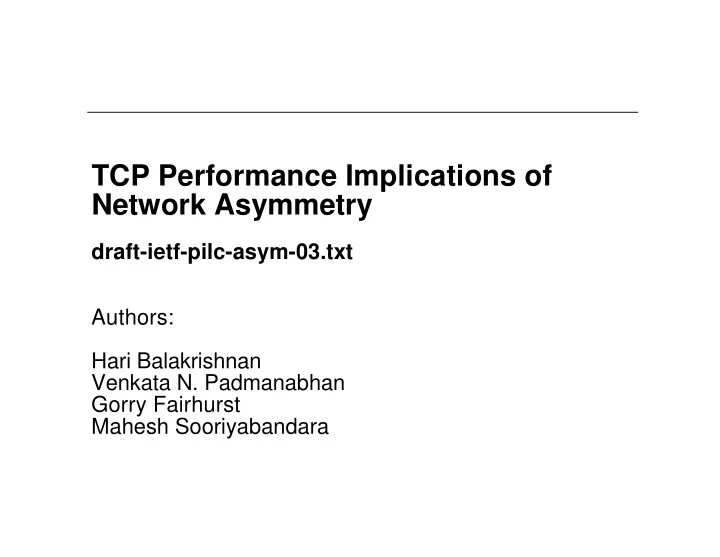

TCP Performance Implications of Network Asymmetry draft-ietf-pilc-asym-03.txt Authors: Hari Balakrishnan Venkata N. Padmanabhan Gorry Fairhurst Mahesh Sooriyabandara
Revisions to the draft Draft -00 (Sept 99) Issued in response to WG charter Draft -01 Added issues and techniques Draft -02 Minor corrections Draft -03 Major Revision Added examples of asymmetric networks Added techniques Techniques organised by type Identify techniques in use Relationship to PEP clarified Recommendations added
Bandwidth Asymmetry Downstream/Forward: Constrained throughput Queue of ACKs Upstream/Reverse: Limited ACK rate Most applications send more than they receive High asymmetry causes return pipe to fill with ACKs
Asymmetry Examples of Asymmetry Asked WG for examples - Please do send more! Links which benefit from a lower return rate Shared medium access High per packet “cost” for many “radio” links Asymmetry benefits such links benefit by design Important note: These slides use a satellite example - The same applies for the other subnetworks !!!
Implications (i) (ii) (i) ACK rate controls TCP send rate (self-clocking) cwnd opens slowly (low ACK rate) Cumulative ACKs generate TCP DATA bursts (ii) ACK Queue builds May drop ACKs Increasing RTT, TCP RTO may expire before loss Slowed reaction time of protocol, (FR etc)
Types of Mitigations (a) End-to-End (various) and/or and or Type 1,3 Type 0,1 Type 2 (b) Transparent (4 types)
End-to-End Mitigations Modified Delayed ACKs REC: Don’t use (difficult to select d ) Large MSS REC: Don’t use IP fragmentation Dynamically vary d REC: Don’t use - remain a research area Other TCP Sender Modifications REC: Don’t use
Transparent Mitigations (type 0) Header Compression Reduces size of ACK RFC1144 (V-J HC) REC: Widely implemented and used May use if low error rate, ordered delivery Benefit with low-to-moderate asymmetry Robust Header Compression (See ROHC WG) REC: Benefit with low-to-moderate asymmetry Benefit with low-to-moderate asymmetry Does not reduce ACK rate Does not mitigate with upstream DATA
Transparent Mitigations (type 1) ACKs suppressed Queue of ACKs Techniques applied before the upstream bottleneck ACK Filtering / Suppression REC: Major benefit, has been deployed May lead to TCP bursts ACK Decimation REC: Major benefit, has been deployed May lead to TCP bursts Some inelegant recovery
Transparent Mitigations (type 2) Techniques applied after the upstream bottleneck Mitigates the effect of stretch ACKs (TCP DATA bursts) ACK Reconstruction (implicit) REC: Desirable Appropriate algorithms remain a research issue ACK Compacting / Companding (explicit) REC: Desirable Appropriate algorithms remain a research issue Are security recommendations (packet amplifier) enough?
Shared Reverse (uplink) DATA & ACKs Sharing reduces capacity per flow for uplink ACKs (i) ACKs from multiple flows (ii) DATA sharing with ACKs Prone to ACK Compression Often a KEY FACTOR
Transparent Mitigations (type 3) Reverse link scheduling Mitigate effect of sharing Scheduler & queue management Per-Flow queues REC: Widely implemented Desirable for all low speed links ACKs First Scheduling Separate queues for DATA and ACKs (hi priority) Used with a scheme to reduce ACK rate REC: Promising Appropriate algorithms remain a research issue
Conclusions Major revision (-03) completed Thanks to ALL who provided new input Intention to correct known mistakes (-04) April More Comments VERY Welcome : Taxonomy correct? More example networks? More mitigations? RECOMMENDATIONS CORRECT?
Recommend
More recommend